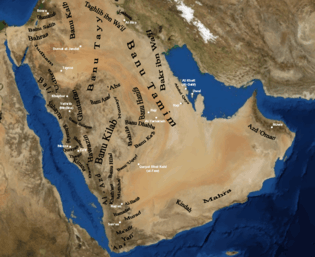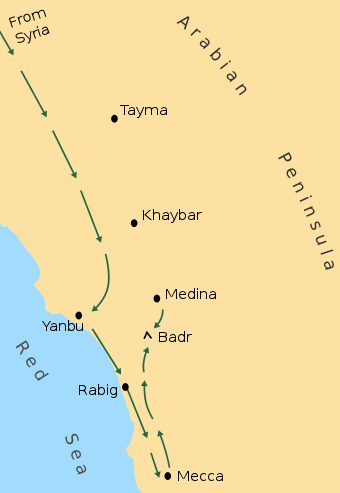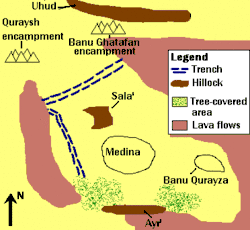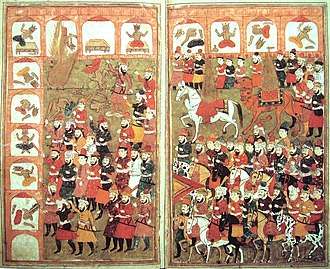Military career of Muhammad
The military career of Muhammad, the prophet of Islam, lasted for the final ten years of his life, from 622 to 632. After he and his small fellowship were pushed out of the holy trading town of Mecca, controlled by the powerful Quraish tribe, he started intercepting Meccan caravans. After his first victory in a pitched battle at Badr in 623, his power grew increasingly and he began to subjugate other tribes through either diplomacy or conquest. In 630 he finally accomplished his long-term goal of conquering Mecca and the Kaaba. By his death in 632, Muhammad had managed to unite most of the Arabian Peninsula, laying the foundation for the subsequent Islamic expansion.
.jpg)
| Part of a series on |
| Muhammad |
|---|
 |
|
Views |
|
Related |
|
History
Lead up to armed conflict

After the death of his uncle Abu Talib in 619, Muhammad, the prophet of Islam, was lacking someone who provided him security in the increasingly hostile climate of Mecca. After several failed attempts to reach for tribes outside of Mecca, he contacted the Banu Khazraj of Medina (then Yathrib). He managed to convert six of them to Islam. In Medina they spread the word of Muhammad and Islam and in February 621, a new delegation reached Mecca, among them two members of the Banu Aws. The Banu Khazraj and Banu Aws were rivals at this time, fighting for control of Medina. Muhammad mediated a ceasefire between the two parties and sent them back to Medina, accompanied by a reciter of the Quran. Islam slowly grew in Medina before in March 622, a new delegation, this time numbering 72 people, consulted with Muhammad. They pledged their readiness to wage war against Muhammad's enemies, while Muhammad also declared his readiness to wage war against the Jews of Medina.[lower-alpha 1] The Meccans, who heard rumors of this meeting and realized that this was a call to war, failed an attempt to assassinate Muhammad in May 622. Muhammad fled, together with his companion Abu Bakr, to Medina, in what is known as the Hijra.[2]
| Wikisource has original text related to this article: |
Medina was divided into five tribes: two of them the Banu Khazraj and Banu Aws, while the Jews were represented by, from smallest to largest tribe, the Banu Qaynuqa, Banu al-Nadir and Banu Quraizah.[3] Upon arrival in Medina he set about the establishment of a pact known as the Constitution of Medina, to regulate the matters of governance of the city, as well as the extent and nature of inter-community relations, and signatories to it included the Muslims, the Ansar and the various Jewish tribes of Medina.[4]
Significant clauses of the constitution included the mutual assistance of each other if one signatory were to be attacked by a third party, the resolution that the Muslims would profess their religion and the Jews theirs, as well as the appointment of Muhammad as the leader of the state.[5]
First caravan raids
Muhammad and his Companions soon engaged in a series of caravan raids. These raids were generally offensive[6] and carried out to gather intelligence or seize the trade goods of caravans financed by the Quraysh, (such retaliation was explained as being legitimate by saying many Muslims' possessions and wealth - left behind when they migrated from Mecca - were stolen).[7][8] The Muslims declared that the raids were justified and that God gave them permission to defend against the Meccans' persecution of Muslims.[9][10] Another reason for the raids appears to have been economic stress, as the food output of Medina was barely capable of feeding the Muslim newcomers. Hence, the raiding of food was mandatory to supplement their diet.[11]
The order of the caravan raids is somewhat confused in the Islamic sources. What seems clear is that there were two types of raids: those led by Muhammad and those led by lieutenants. They featured somewhere between seven and 200 warriors, typically on foot.[12] These fighters were, at last initially, provided almost exclusively by the Muhajirun, the Muslim migrants from Mecca. Consisting primarily of unemployed young men, they had the chance to place their name in a register if desiring to go on a raid.[13]
The first year of these raids was a "near total failure".[14] All Meccan caravans managed to evade Muhammad's forces or were accompanied by forces with superior numbers, suggesting that the Quraish relied on a spy among the core of the Muslim community. Aware of this problem, Muhammad introduced the usage of sealed letters of instructions and appointed Abd-Allah ibn Jahsh to lead an expedition of eight or twelve men. After marching two days, ibn Jahsh opened the letter to learn that, according to most sources, he was instructed to gain intelligence information about the movement of Meccan caravans deep in Quraish territory, in Nakhlah. Soon the expedition met a Meccan caravan, weakly protected by only four guards. The Muslims encountered the caravan in a holy month where fighting was forbidden, and it also seems that Muhammad did not order the usage of violence. Despite this, the Muslim warriors collectively decided to attack and approached the caravan disguised as pilgrims. When close enough they leaped upon the guards: one of whom escaped, two were seized and one was killed.[15] The victim, named Amr b. al-Hadrami, was the first person killed for the cause of Islam.[16]
Ibn Jahsh and his men returned to Medina with the seized caravan,[17] which carried wine, leather goods and raisins.[18]
First pitched battles
Battle of Badr

On 16 December 623 Muhammad faced the Meccans in a first pitched battle, the Battle of Badr.[19] The prelude revolved around Muhammad's plan to raid a major Meccan caravan which was on its way from Syria to Mecca. It was of monumental size, comprising 1000 camels transporting tens of thousands of dinars, and was escorted by 70 horsemen. Attacking this caravan would have forced Mecca into action, as virtually every Quraysh family had invested in it. Despite this risk Muhammad began the preparations before finally setting out on December 9, 623, with a force of around 314 men, 70 camels and two horses. Muhammad and his warriors marched offside the common roads to avoid Meccan scouts, passing through little-known canyons and wadis.[20]
The Quraysh leader Abu Sufyan, who accompanied the caravan and realized that Muslim scouts were nearby, ordered the caravan to take a different route to leave the danger zone and sent a messenger to Mecca. After the latter arrived in Mecca and told the Quraysh that a Muslim attack was imminent, a Meccan relief force of 1000 men, many of them wearing mail armour, was sent. Abu Jahl, who led the relief army, pressed northwards to where he expected the Muslim army to be: at Badr. While marching, however, around 200–400 warriors left his army and headed back to Mecca.[21]
.jpg)
Muhammad was unaware of the Meccan army until one day before contact, when his men captured two Quraysh waterbearers.[22] The Muslims took up a defensive position. The battle started off with a duel between three Muslim and three Meccan champions, which the Muslims decided in their favour. Afterwards the two armies exchanged arrow fire, before finally clashing.[23] According to the Quran,[lower-alpha 2] thousands of angels descended from heaven and participated in the battle, being instructed by Allah to "smite the [Meccan warrior's] necks and smite of them each finger."[lower-alpha 3] According to another Quranic verse,[lower-alpha 4] Allah fought and killed the Meccans representatively for the Muslim warriors.[27]
The Meccan army eventually collapsed soon after the horse of Abu Jahl was brought down,[28] resulting in the first major Muslim victory.[29] This victory must not so much be ascribed to divine intervention as is done in the Islamic sources, but had several conventional reasons, like the Meccan inability to use their cavalry, the questioned leadership of Abu Jahl,[lower-alpha 5] the Meccan lack of access to water and the higher morale of the Muslims.[31] The battle took the lives of 14 Muslims, while the Meccan casualties numbered 50–70. A similar number of them were captured and were either executed or kept for ransom.[29] The Meccan general Abu Jahl survived the battle, but with mortal injuries. A Muslim warrior found him, decapitated him and presented his head to Muhammad. Many more Quraysh noblemen had died in the fighting, which posed a significant blow to the Quraysh.[32] Muhammad thought about pursuing the Meccan caravan, but then decided to return to Medina instead.[33]
Battle of Uhud
Muhammad also participated in the Battle of Uhud. Since the Quraysh were planning to attack the Muslims from behind, Muhammad placed 50 archers on a small mountain called Mount Ruma. Their job was to shoot arrows when the group of horsemen tried to attack from behind. When the Muslims were getting victorious, 40 of the archers left their place. So the Quraysh attacked from behind. When the Quraysh attacked from behind, Muhammad did not know what to do. Finally, he started to fight to save the Muslims, but he got injured on his shoulder and his lower right tooth was broken. But he still continued to fight.
Battle of the Trench
With the help of Banu Nadir, the exiled Jewish tribe from Medina, Abu Sufyan, the military leader of the Quraysh mustered a force of 10,000 men. Muhammad was able to prepare a force of about 3,000 men. He had however adopted a new form of defense, unknown in Arabia at that time: Muslims had dug trenches wherever Medina lay open to cavalry attack. The idea is credited to a Persian convert to Islam, Salman. The digging of the trench began on Monday, 29 December 626 (5 Shawwal AH 5) and took six days. On Saturday 3 January 627 (10 Shawwal) the confederates encamped and Muhammad rode out at the head of his army to confront them. The siege lasted twenty nights,[34] until the early morning of Saturday, 24 January (1 Dhul-Qada), not two weeks as claimed by Watt.[35] Watt's date of 14 April for the end of the siege is also incorrect, being according to the fixed calendar which was not introduced for another five years. Abu Sufyan's troops were unprepared for the fortifications they were confronted with, and after an ineffectual siege, the coalition decided to go home.[36] The campaign lasted 27 days. The immediate cause was harsh winter weather, which would not have been experienced in mid-April.[37] The Qur'an discusses this battle in verses 9-27 of sura 33, Al-Ahzab.[38][39]

During the Battle of the Trench, the Jewish tribe of Banu Qurayza who were located at the south of Medina were charged with treachery. After the retreat of the coalition, Muslims besieged Banu Qurayza, the remaining major Jewish tribe in Medina. The Banu Qurayza surrendered and all the men were beheaded, apart from a few who converted to Islam, while all the women and children were enslaved.[40][41] In dealing with Muhammad's treatment of the Jews of Medina, aside from political explanations, western historians and biographers have explained it as "the punishment of the Medina Jews, who were invited to convert and refused, perfectly exemplify the Quran's tales of what happened to those who rejected the prophets of old."[42] F. Peters adds that Muhammad was possibly emboldened by his military successes and also wanted to push his advantage. Economical motivations according to Peters also existed since the poorness of the Meccan migrants was a source of concern for Muhammad.[43] Peters argues that Muhammad's treatment of the Jews of Medina was "quite extraordinary" and is "quite at odds with Muhammad's treatment of the Jews he encountered outside Medina."[44] According to Welch, Muhammad's treatment of the three major Jewish tribes brought Muhammad closer to his goal of organizing a community strictly on a religious basis.[45]
Battle of Khaybar
In 628, the Jews and the Banu Ghatafan were planning to attack the Muslims. When Muhammad heard that they were coming, he gathered an army of 1,500 soldiers and started their journey to Khaybar. On the other side, the Banu Ghatfan were afraid that the Muslims would attack them at any time, so they refused to help the Jews at Khaybar. In Khaybar, there were 8 big forts. The Muslims attacked and controlled 6 of the Jews' forts. Later, the Jews surrendered to the Muslims. 2 of their commanders were killed in the battle.
Hudaybiyyah
By old custom, during the months of pilgrimage, tribal hostilities stopped and all were free to visit Mecca. In March 628, Muhammad put on the garb of a pilgrim and taking a force and camels for sacrifice, set out for Mecca.[46] According to the early chronicler Ibn Ishaq, Muhammad took 700 men (Guillaume 1955, p. 500). According to Watt, Muhammad took 1400 to 1600 men (Watt 1957, p. 46).
The Meccans did not accept the Muslim professions of peaceful intent and sent out an armed party against them. The Muslims evaded them by taking a side route through the hills around Mecca, and then camped outside Mecca, at Hudaybiya. Ibn Ishaq describes a tense period of embassies and counter-embassies, including a bold foray by Uthman ibn Affan into the city of Mecca, where he was temporarily held as a hostage. The Meccans told the Muslims that Uthman had been killed and open warfare seemed imminent.
Then the situation shifted radically. Uthman was revealed to be alive, and the Meccans expressed their willingness to negotiate a truce. Some elements wanted a confrontation, but Muhammad held out for a peaceful resolution.
The treaty of Hudaybiyyah committed both sides to a ten-year truce. The Muslims were to be allowed to return the next year, to perform the pilgrimage.
Muslim alliance expands
Free of the Meccan threat, the Muslims expanded their activities against other oases and tribes. They conquered the rich oasis of Khaybar (see Battle of Khaybar) and sent raiding parties against the Ghatafan, Murrah, Sulaym, and Hawaizin (Watt 1957 pp. 52–53).
Conquest of Mecca

Less than two years after the truce of Hudaybiyyah, the truce was broken by a squabble between tribes allied to the Meccans and Medinans. There had long been bad blood between the Khuza'ah and the Banu Bakr bin Abd Manat, and the two groups lined up on opposite sides, the Khuza'ah with the Muslims and the Banu Bakr with the Meccans . Watt (p. 62) says that some of the Quraysh helped the Banu Bakr ambush the Khuza'ah.
Shortly afterwards, a Muslim force of 10,000 men headed for Mecca. They camped outside Mecca and the usual round of emissaries and negotiations began. Apparently Abu Sufyan had negotiated, then or earlier, a promise that he and those under him would not be attacked if they surrendered peacefully. A few Meccans from the Makhzum faction, prepared to resist. The Muslims conquered Mecca successfully.
On or near January 11, 630, Muhammad sent four columns of troops into Mecca. Only one column met any resistance. Twenty-eight Meccans were killed and the rest of those opposing the Muslim entry fled. The remaining Meccans surrendered to Muhammad. Some of the Meccans, even those who had been notable for their opposition to Islam, were spared.[47] Ten people were ordered to be killed: Ikrimah ibn Abi-Jahl, Abdullah ibn Saad ibn Abi Sarh, Habbar bin Aswad, Miqyas Subabah Laythi, Huwairath bin Nuqayd, Abdullah Hilal and four women who had been guilty of murder or other offences or had sparked off the war and disrupted the peace.
The Kaaba was cleansed of all the idols of Arabian gods, such as Hubal, which were placed in it and the area was established as a Muslim sanctuary.[48] While destroying each idol, Muhammad recited Surah 17:81:[49][50]
- "And say: Truth hath come and falsehood hath vanished away. Lo! falsehood is ever bound to vanish."[51]
However, according to one Shia tradition, he ordered an icon of Virgin Mary and Baby Jesus which was in the Ka'aba not to be destroyed.[52]
Statistics
Casualties
The total of all casualties on all sides in all the battles of Muhammad might be more or less 1000. A contemporary Islamic scholar, Maulana Wahiduddin Khan, says that "during the 23-years in which this revolution was completed, 80 military expeditions took place. Fewer than 20 expeditions actually involved any fighting. 259 Muslims and 759 non-Muslims died in these battles – a total of 1018 dead."[53]
Views
Muslim View
Javed Ahmed Ghamidi writes in Mizan that there are certain directives of the Qur’an pertaining to war which were specific only to Muhammad against Divinely specified peoples of his times (the polytheists and the Israelites and Nazarites of Arabia and some other Jews, Christians, et al.) as a form of Divine punishment—for they had persistently denied the truth of Muhammad's mission even after it had been made conclusively evident to them by Allah through Muhammad, and asked the polytheists of Arabia for submission to Islam as a condition for exoneration and the others for jizya and submission to the political authority of the Muslims for military protection as the dhimmis of the Muslims. Therefore, after Muhammad and his companions, there is no concept in Islam obliging Muslims to wage war for propagation or implementation of Islam, hence now, the only valid reason for war is to end oppression when all other measures have failed. (jihad)[54][55]
See also
- Book:Military career of Muhammad
- Rules of war in Islam
- Jihad
- Itmaam-i-hujjat
- Muslim conquests
Annotations
- "Its declaration to wage war against Muhammad's enemies was one crucial aspect of the Second Pledge of al-Aqaba. (....) During the negotiations before the pledge was made, one of the members of the Madinah delegation asked the Prophet about previous alliances they had made with the Jews [of Medina], expressing his concern that once Muhammad was victiorious, he might leave them to face the defeated Jews alone. To this the Prophet declared that "I will war against them that war against you and be at peace with those at peace with you." The implication was clear: The Second Pledge of al-Aqaba was against any who opposed Islam, and this pledge would invalidate previous treaties–principally those with the Jews of Madinah."[1]
- "Allah had already given you the victory at Badr, when ye were contemptible. So observe your duty to Allah in order that ye may be thankful.(3:123) When thou didst say unto the believers: Is it not sufficient for you that your Lord should support you with three thousand angels sent down (to your help)?(3:124) Nay, but if ye persevere, and keep from evil, and (the enemy) attack you suddenly, your Lord will help you with five thousand angels sweeping on."(3:125)[24]
- "When thy Lord inspired the angels, (saying): I am with you. So make those who believe stand firm. I will throw fear into the hearts of those who disbelieve.Then smite the necks and smite of them each finger."(8:12)[25]
- "Ye (Muslims) slew them not, but Allah slew them. And thou (Muhammad) threwest not when thou didst throw, but Allah threw, that He might test the believers by a fair test from Him. Lo! Allah is Hearer, Knower."(8:17)[26]
- Abu Jahl's initial task was merely the protection of the caravan, but he decided to bring the confrontation to the Muslims, possibly for the gain of glory or because he realized the need to extinguish the Muslim insurgency.[30] The behaviour of Abu Jahl eventually resulted in divisions among the Quraysh warriors.[31]
Notes
- Rodgers 2012, p. 48.
- Rodgers 2012, pp. 45–50.
- Rodgers 2012, p. 54.
- Ibn Hisham, as-Seerat an-Nabawiyyah, Vol. I p. 501.
- al-Mubarakpuri (2002) p. 230.
- Montgomery Watt, William (21 January 2010). Muhammad: prophet and statesman. Oxford University Press, 1974. p. 105. ISBN 978-0-19-881078-0.
- Mubarakpuri, Safiur-Rahman. When the moon split (PDF). Riyadh. p. 146.
- Gabriel, Richard A. (2008), Muhammad, Islam's first general, University of Oklahoma Press, p. 73, ISBN 978-0-8061-3860-2.
- Welch, Muhammad, Encyclopedia of Islam.
- See:
- Watt (1964) p. 76;
- Peters (1999) p. 172
- Michael Cook, Muhammad. In Founders of Faith, Oxford University Press, 1986, page 309.
- Rodgers 2012, pp. 71-73.
- Rodgers 2012, p. 78.
- Rodgers 2012, pp. 60-61.
- Rodgers 2012, p. 83.
- Rodgers 2012, pp. 83-85.
- Watt 1956, p. 6.
- Rodgers 2012, p. 85.
- Rodgers 2012, p. 84.
- Mikaberidze 2011, p. 165.
- Rodgers 2012, pp. 88–90.
- Rodgers 2012, pp. 90–91.
- Rodgers 2012, p. 92.
- Mikaberidze 2011, pp. 165–166.
- Pickthall 1930, 3:123–125.
- Pickthall 1930, 8:12.
- Pickthall 1930, 8:17.
- Abdel-Samad 2016, pp. 105–106.
- Rodgers 2012, p. 97.
- Mikaberidze 2011, p. 166.
- Rodgers 2012, p. 91.
- Rodgers 2012, p. 99.
- Rodgers 2012, p. 98.
- Rodgers 2012, pp. 100–101.
- Ibn Kathir. The life of the Prophet Muhammad (PDF). 3. p. 148.
- Watt (1956), p. 36, 37.
- Rodinson (2002), pp. 209–211.
- Ibn Kathir. The life of the Prophet Muhammad (PDF). 3. p. 152.
- Quran 33:9–27
- Uri Rubin, Quraysh, Encyclopaedia of the Qur'an
- Peterson, Muhammad: the prophet of God, p. 126
- Tariq Ramadan, In the Footsteps of the Prophet, Oxford University Press, p. 141
- Francis Edward Peters (2003), p. 77
- F.E.Peters (2003), pp. 76–8.
- Francis Edward Peters (2003), p. 194.
- Alford Welch, Muhammad, Encyclopedia of Islam
- "The Event of Hudaybiyyah".
- The Message by Ayatullah Ja'far Subhani, chapter 48 referencing Sirah by Ibn Hisham, vol. II, page 409.
- Karen Armstrong (2000,2002). Islam: A Short History. p. 11. ISBN 978-0-8129-6618-3. Check date values in:
|date=(help) - Islam, iconography and the Taliban Archived 2008-03-02 at the Wayback Machine
- Conquest of Makkah Archived 2009-02-01 at the Wayback Machine - USC MSA
- Pickthall 1930, 17:81.
- {http://www.bliis.org/essay/prophet-muhammad-jesus-marys-icons-kaba/}
- Maulana Wahiduddin Khan, Muhammad: A Prophet for All Humanity, goodword (2000), p. 132
- Javed Ahmed Ghamidi, Mizan, Chapter:The Islamic Law of Jihad, Dar ul-Ishraq, 2001. OCLC: 52901690
- Misplaced Directives, Renaissance Archived 2006-08-13 at the Wayback Machine, Al-Mawrid Institute, Vol. 12, No. 3, March 2002."Archived copy". Archived from the original on 2006-11-15. Retrieved 2006-10-05.CS1 maint: archived copy as title (link)
References
- Abdel-Samad, Hamed (2016). "Der Koran. Botschaft der Liebe. Botschaft des Hasses" (in German). Droemer. ISBN 3426277018. Cite journal requires
|journal=(help)CS1 maint: ref=harv (link) - Donner, Fred (1981). The Early Islamic Conquests. Princeton University Press. ISBN 9780691101828.CS1 maint: ref=harv (link)
- Mikaberidze, Alexander (2011). "Badr, Battle of". In Mikaberidze, Alexander (ed.). Conflict and Conquest in the Islamic World: A Historical Encyclopedia. ABC–CLIO. pp. 165–166. ISBN 1598843362.CS1 maint: ref=harv (link)
- Pickthall, Muhammad M. (1930). The Quran.CS1 maint: ref=harv (link)
- Rodgers, Russ (2012). The Generalship of Muhammad: Battles and Campaigns of the Prophet of Allah. University Press of Florida. ISBN 9780813042718.CS1 maint: ref=harv (link)
- William Montgomery Watt (1956). Muhammad at Medina. Oxford University Press.CS1 maint: ref=harv (link)
- William Montgomery Watt (1974). Muhammad: prophet and statesman. Oxford University Press.CS1 maint: ref=harv (link)
- al-Mubarakpuri, Safi-ur-Rahman (2002). The Sealed Nectar: Biography of the Noble Prophet. Darussalam. ISBN 1-59144-071-8.CS1 maint: ref=harv (link)
Further reading
- Berger, Lutz (2016). Die Entstehung des Islam. Die ersten hundert Jahre (in German). C. H. Beck. ISBN 3406696937.CS1 maint: ref=harv (link)
- Gabriel, Richard A. (2007). Muhammad: Islam's First Great General. University of Oklahoma Press. ISBN 978-0806138602.
- Kister, M. J. (1986). "The Massacre of the Banū Qurayẓa: A Re-examination of a Tradition". Jerusalem Studies in Arabic and Islam. 8. ISSN 0334-4118.CS1 maint: ref=harv (link)
- Lings, Martin (1983). Muhammad: His Life Based on the Earliest Sources. Inner Traditions. ISBN 978-0946621330.CS1 maint: ref=harv (link)